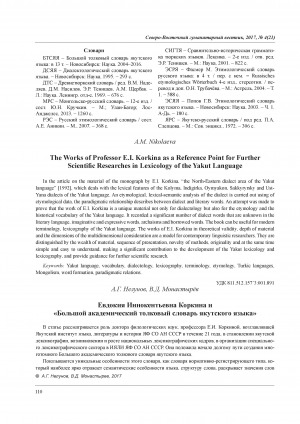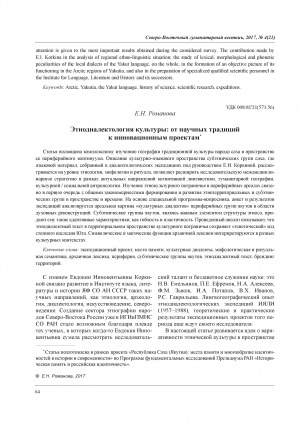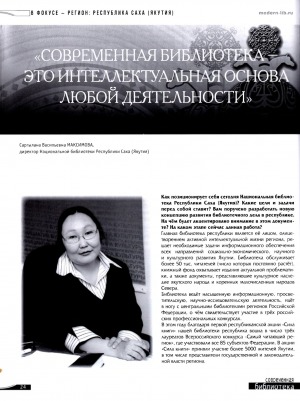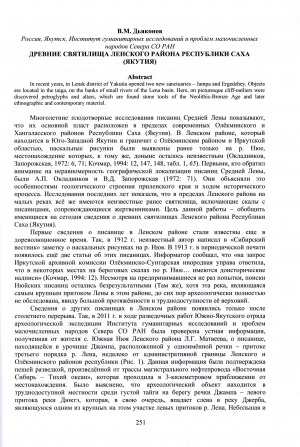- Книга (1124)
- Газета (3)
- Журнал (55)
- Автореферат диссертации (10)
- Изоиздание (2)
- Аудиоиздание (23)
- Видеоиздание (371)
- Картографическое издание (13)
- Неопубликованный документ (1)
- Нотное издание (6)
- Фотография (210)
- Статья (89)
- Библиографический указатель (30)
- Словарь (37)
- Брошюра (26)
- Буклет (19)
- 3D-модель (35)
- Грампластинка (2)
- Веб-архив (260)
- Литературно-художественные издания (144)
- Официальные издания (50)
- Научные издания (399)
- Научно-популярные издания (857)
- Информационные издания (386)
- Справочные издания (69)
- Учебные издания (122)
- Производственно-практические издания (16)
- Массово-политические издания (42)
- Изобразительное издание (231)
Количество страниц: 8 с.
- Коркина Евдокия Иннокентьевна > Литература о жизни и деятельности,
- Саха тыла/Якутский язык > Исследования якутского языка. Языковеды,
- Языки народов Якутии > Якутский язык > Исследования якутского языка. Языковеды,
- Языкознание. Филология. Художественная литература > Языкознание и языки. Лингвистика > Якутский (саха),
- НАУКА ЯКУТИИ > ЯЗЫКОЗНАНИЕ. ФИЛОЛОГИЯ. ЛИТЕРАТУРОВЕДЕНИЕ. ХУДОЖЕСТВЕННАЯ ЛИТЕРАТУРА > Языкознание и языки. Лингвистика,
- iYakutia > Языки народов Якутии > Якутский язык.
The article is devoted to the role of the Doctor of Philology, Professor E.I. Korkina, who headed the Yakut Institute of Language, Literature and History for 21 years, in the formation of the Yakut lexicography, in the emergence and growth of national experts and researchers in lexicography, as well as her merit in organizing a special Department at the Institute of Language, Literature and History of the Yakutsk Branch of the USSR Academy of Sciences. She marked the beginning of a long way to create the Great multi-volume academic explanatory dictionary of the Yakut language. The unique features of this dictionary is revealed, as a dictionary of the standard-recording type, which refl ects the semantic features of the language, the structure of the word as much as possible, reveals the meanings of words with the help of all the means of lexicographic science. The vivid examples of compliance with these requirements are the entries written by Evdokiya Innokentyevna Korkina, some of which are presented in this article. E.I. Korkina is not only the organizer of lexicographical work at the Institute, but also made a personal practical contribution to the development of dictionary articles of the last volumes of the Great Explanatory Dictionary. The article gives a brief history of Yakut lexicography, which originated as bilingual and in many ways determined the further development of the Yakut lexicography.
Нелунов, А. Г. Евдокия Иннокентьевна Коркина и "Большой академический толковый словарь якутского языка" / А. Г. Нелунов // Северо-Восточный гуманитарный вестник. — 2017. — N 4 (21). — С. 110-116.
Количество страниц: 8 с.
The article is devoted to the comprehensive study of the geography of the traditional culture of the Sakha people in the space of its peripheral continuum Description of the cultural-linguistic space of the sub-ethnic groups of Sakha, where the language material collected in the dialectological expeditions under the leadership of E.I. Korkina, is considered at the level of Ethnology, mythology and ritual allows to expand interdisciplinary research strategy in the contemporary areas of cognitive linguistics, humanitarian geography, cultural/social anthropology. The study of ethnocultural borderlands in the peripheral areas is primarily linked with the general patterns of formation and development of ethno-territorial and sub-ethnic groups in space and time. On the basis of special application program, questionnaire and results of the expeditions is analyzed the areal picture of the “cultural dialects” of peripheral groups of the Yakuts in the field of spiritual reconstruction. Sub-ethnic groups of the Yakuts, arc an important element of the structure of the ethnos, give it such adaptive characteristics such as flexibility and ductility. The analysis shows that enthnodialect text in the territorial space of cultural borderland saves the “genetic” code of the steppe heritage of the South. The symbolic and magical function of archaic vocabulary is interpreted in different cultural contexts.
Романова, Е. Н. Этнодиалектология культуры: от научных традиций к инновационным проектам / Е. Н. Романова // Северо-Восточный гуманитарный вестник. — 2017. — N 4 (21). —C. 64-70.
Количество страниц: 5 с.
- Прикладные науки. Медицина. Ветеринария. Техника. Сельское хозяйство > Различные отрасли промышленности и ремесел,
- НАУКА ЯКУТИИ > ПРИКЛАДНЫЕ НАУКИ. МЕДИЦИНА. ТЕХНИКА. СЕЛЬСКОЕ ХОЗЯЙСТВО > Инженерное дело. Техника в целом,
- НАУКА ЯКУТИИ > ПРИКЛАДНЫЕ НАУКИ. МЕДИЦИНА. ТЕХНИКА. СЕЛЬСКОЕ ХОЗЯЙСТВО > Различные отрасли промышленности и ремесел,
- iYakutia > Бренды Якутии > Хомус – якутский варган.
The present work opens a planned series of articles devoted to materials research of metal products of modern national culture, instruments of work, weapons and household items made in the past by local blacksmiths. These studies are conducted in order to provide technical assistance to national masters, local historians, researchers of a metallurgical culture of the Yakuts. Yakut khomuses are very popular and there is a need of serial production of quality "melodious" khomuses using modern technologies of metal processing. In this context, this paper discusses metallography aspects of the application of laser cutting to accelerate a process of manufacturing a workpiece of khomus body. Influence of laser cutting on metal structure of khomus body was investigated. A comparative analysis of changes in the microstructure and microhardness of a cut surface of metallic khomus body after laser and mechanical cutting is conducted. The thickness of a laser affected zone is defined. It is established that for cutting workpieces of khomus body it is possible to use a laser cutting, which provides high efficiency of the process in combination with high quality of cut surfaces.
Применение лазерной резки для изготовления корпуса хомуса (варган) из листовой стали / М. П. Лебедев, С. Н. Махарова, С. П. Яковлева, А. Р. Александров // Наука и образование. – 2015. – N 1 (77). – C. 70-74.
Количество страниц: 7 с.
The article deals with the preliminary results of a comprehensive study of insufficiently studied group of the Russian old residents, who live in Pokhodsk village in the Nizhnekolymskiy region of the Republic of Sakha (Yakutia). The origin and the main vector of formation of the traditional culture of this ethnic group has been considered on the basis of archaeological, ethnographic and written sources. The main emphasis was placed on the study of life support systems - housing, clothing, food. Analysis of the remains of buildings and the most expressive objects from archaeological excavations, data about the native places of migrants in XVII century led to the conclusion that the pohodchan's traditional culture is based on traditions of different places of modern Vologda region. Further development followed the path of preserving the traditions and with inevitable contact with the surrounding nations that did not have a fundamental impact on the spheres of life-support of the Russian old-timers. Thus, by the beginning of XIX century, a peculiar cultural tradition of Russian old-timers in the lower reaches of the Kolyma River had been formed.
Строгова, Е. А. Происхождение и формирование культурных традиций русской старожильческой группы "походчане" в низовьях Колымы=The genesis of the cultural traditions of old-Russian group "pohodchans" in the lower reaches of the Kolyma River / Е. А. Строгова // Древние культуры Монголии, Байкальской Сибири и Северного Китая : материалы VII международной научной конференции, Красноярск, 3-7 октября 2016 г. — Красноярск : Сибирский федеральный университет, 2016. — Т. 2. — С. 191-197.
Количество страниц: 6 с.
This paper aims to reconstruct the funeral rites of the early Yakut culture before arrival of Russians. It is based on the analysis of the burial composition and the ritual sphere of the funerary monuments of XIV–XVII centuries. The distinguishing feature of the burial composition of this time is a small depth of the burial pit, which on average is 0,48 cm deep. Box coffins are more common, and their parameters and structure are similar to those of the Hun coffins, with a similar external camera - grobovina, a special section for grave goods, and a lengthwise dividing wall in joint burials. The western orientation of the dead is associated with the traditional worldview about the geography of the world of the dead. The dead were buried horizontally lying on their back or in a crouched position lying on their side, sometimes with the head of the deceased resting on the saddle. The accompanying grave goods consist of household items, horse equipment, weapons and hunting tools, clothing and jewellery, as well as food for the journey in the form of lumps of a young horse. In At Dabaan III burial, there was discovered a pit with a dismembered horse next to the burial of the boy. The early Yakut burials are genetically related to the whole layer of ancient and medieval cultures of the Eurasian steppes in many respects. Their origin can be traced in archaeological complexes of Central Asia, Siberia and the Far East, where the funeral traditions of the medieval tribes of Baikal region and the Amur region are their nearest equivalents.
Бравина, Р. И. Погребальная обрядность раннеякутской культуры XIV-XVII вв.=Funeral rites of early Yakut culture of XVI–XVII centuries / Р. И. Бравина // Древние культуры Монголии, Байкальской Сибири и Северного Китая : материалы VII международной научной конференции, Красноярск, 3-7 октября 2016 г. — Красноярск : Сибирский федеральный университет, 2016. — Т. 2. — С. 160-165.
Количество страниц: 4 с.
Yakuts served the deceased as for a distant journey: dressed in road clothes, supplied with a food reserve, changing clothes, etc. The influential deceased went to a final journey accompanied by a horse and the servant. The world of the dead was somewhere in the West and was arranged in the same way as the sociocultural arrangement of earthly life of the living.
Бравина, Р. И. Представления якутов о загробном мире : (по фольклорным, этнографическим и археологическим источникам) / Р. И. Бравина // Интеграция археологических и этнографических исследований. — Иркутск : Иркутский государственный технический университет ; Омск : Омский филиал Института археологии и этнографии СО РАН, 2013. — Т. 2. — С. 163-166.
Количество страниц: 5 с.
- Религия. Теология,
- Краеведение. Археология. География. Биографии. История > Историческая наука. Историография > Археология,
- Краеведение. Археология. География. Биографии. История > Историческая наука. Историография > История Якутии > Древняя Якутия,
- НАУКА ЯКУТИИ > РЕЛИГИЯ. ТЕОЛОГИЯ,
- НАУКА ЯКУТИИ > КРАЕВЕДЕНИЕ. ГЕОГРАФИЯ. БИОГРАФИИ. ИСТОРИЯ > Историческая наука. Историография,
- iYakutia > Древняя Якутия.
In recent years, in Lensk district of Yakutia opened two new sanctuaries - Jampa and Ergedzhey. Objects are located in the taiga, on the banks of small rivers of the Lena basin. Here, on picturesque cliff-outliers were discovered petroglyphs and altars, which are found stone tools of the Neolithic-Bronze Age and later ethnographic and contemporary material.
Дьяконов, В. М. Древние святилища Ленского района Республики Саха (Якутия) / В. М. Дьяконов // Интеграция археологических и этнографических исследований. — Иркутск : Иркутский государственный технический университет ; Омск : Омский филиал Института археологии и этнографии СО РАН, 2013. — Т. 2. — С. 251-255.
Количество страниц: 4 с.
- Общественные науки. Образование > Этнография. Обычаи. Жизнь народа. Нравы,
- Прикладные науки. Медицина. Ветеринария. Техника. Сельское хозяйство > Жилищно-коммунальное хозяйство. Домоводство. Бытовое обслуживание,
- НАУКА ЯКУТИИ > ОБЩЕСТВЕННЫЕ НАУКИ > Этнография. Обычаи. Жизнь народа. Нравы,
- НАУКА ЯКУТИИ > ПРИКЛАДНЫЕ НАУКИ. МЕДИЦИНА. ТЕХНИКА. СЕЛЬСКОЕ ХОЗЯЙСТВО > Жилищно-коммунальное хозяйство. Домоводство. Бытовое обслуживание,
- iYakutia > Хранители традиций > Якуты > Национальный праздник Ысыах,
- iYakutia > Бренды Якутии > Национальный якутский праздник Ысыах.
Степанов, К. М. Ысыах Олонхо как показатель сохранения традиционной системы питания народа саха / Степанов Константин Максимович, доктор сельскохозяйственных наук // Эпическое наследие народов Якутии: традиции и современность. — Якутск, 2018. — С. 211-214.









